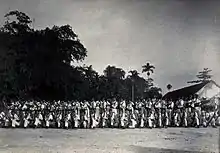Sarawak Rangers
The Sarawak Rangers were a para-military force founded in 1862 by the second White Rajah of the Raj of Sarawak, Charles Brooke.[1] They evolved from the fortmen which were raised to defend Kuching in 1846. The Sarawak Rangers were first commanded by William Henry Rodway, briefly in 1862 and again from 1872 to his retirement in 1881, and were highly skilled in jungle warfare and general policing duties, being equipped with various western rifles, cannons and native weaponry.


.JPG.webp)
They were based in a number of forts constructed at strategic locations in towns and at river mouths. Aside from protecting Sarawak's borders, they were used to fight any rebels and were engaged in a number of campaigns during their history. In times of emergency or war, they could depend on the support of the local population and tribespeople.
The Sarawak Rangers were disbanded for a few years until 1932,[2] only to be reformed as Sarawak Constabulary and mobilised for the Second World War in which they attempted to defend Sarawak from Japanese invasion in 1942 at the start of the Pacific War. After the abdication of Charles Vyner Brooke in 1946 and the creation of the Crown Colony of Sarawak, the Sarawak Rangers became a colonial unit under direct British control and saw action in both the Malayan Emergency and the Borneo Confrontation.[3][4]
In 1963, upon the formation of Malaysia, the Sarawak Rangers were transformed into the 1st Battalion, Royal Ranger Regiment.[5]
See also
References
- Nicholas Tarling (29 August 2003). Imperialism in Southeast Asia. Routledge. pp. 319–. ISBN 1-134-57081-3.
- DeWitt C. Ellinwood, Jr.; Cynthia H. Enloe (1978). Ethnicity and the Military in Asia. Transaction Publishers. pp. 201–. ISBN 978-1-4128-2290-9.
- A. J. Stockwell; University of London. Institute of Commonwealth Studies (2004). Malaysia. The Stationery Office. pp. 70–. ISBN 978-0-11-290581-3.
- Robert Rizal Abdullah (2008). My Adventure. Metier Books. pp. 79–. ISBN 978-1-60594-145-5.
- J P Cross (21 February 2008). Jungle Warfare: Experiences and Encounters. Pen and Sword. pp. 203–. ISBN 978-1-84415-666-5.